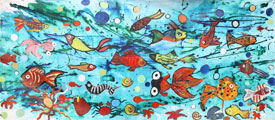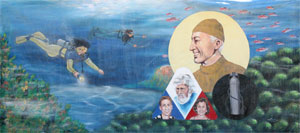Pyramid Replica on Display at UC Irvine
By Anna Lynn Spitzer
|
Irvine, Calif., Nov. 12, 2008 -- To some, a mile is simply a measurement. To Joanne Tawfilis, it represents an attempt to bring people in the world closer to one another.
Tawfilis, a former U.N. executive, founded and directs the Art Miles Mural Project, an effort to create 12 miles of murals – 5,280 to be exact – painted by people of all ages and cultures around the world. The murals will be displayed on an enormous pyramid to be unveiled in Giza, Egypt in 2010.
Each mile contains 440 murals that represent one of 12 themes; Tawfilis sees the undertaking as a way to erase boundaries between countries, and encourage understanding of and respect for the Earth and its many cultures.
A smaller replica of the pyramid will be on display in the Calit2 Atrium at UC Irvine Nov. 12-21, in conjunction with H2Ology, the next offering in the Igniting Technology speaker series.
Measuring 10x10 feet and standing nine feet high, it is screen-printed with 500 of the completed murals representing the 12 themes: multiculturalism, the environment, indigenous people, women, seniors, children, music, heroes, peace/unity and healing, sports, fairy tales and celebrity.
|
||||
The black nylon, four-sided pyramid, presented by UCI’s Urban Water Research Center, will be open to the public. “The Art Miles Mural Project links art, technology, children and the world to provide a path through international cooperation for sustainability,” says UWRC director Bill Cooper.
The replica will also be on display at the UCI Student Center in early December to coincide with the Dec. 1-5 International Conference on Water Scarcity, Global Changes and Groundwater Management Responses. It then will travel to Park City, Utah for the Sundance Film Festival.
The Art Miles Mural Project was born 10 years ago. Tawfilis, then director of the Women of Srebrenica Project, was volunteering her free time at a Bosnian orphanage, where the children wanted to make a “big painting.” They painted on the only material she could find, a bullet-riddled bed sheet. That first mural was the catalyst for the project that now aims to “unite individuals of different backgrounds and across borders, using a blank canvas, building relationships and achieving cooperation.”
|
To date, more than 500,000 people in 125 countries have participated, completing more than 4,000 murals.
Tawfilis is currently in Egypt, working with government agencies on development of final arrangements for the pyramid’s construction and presentation. “We’re working through the ministries of culture, environment, tourism, education and the secretary general of the Supreme Council of Antiquities,” she says. “They want it to be a true art/cultural/educational exposition.”
The placement of the Art Miles pyramid is planned for a location near the three great pyramids of Giza, and will debut at the end of the United Nations’ “Decade for Culture of Peace and Non-Violence for the Children of the World.” The murals, which measure 5x12-ft., will be digitized and printed onto a “skin” that covers its frame. Tarek Naga, a world renowned architect, is consulting on the design of the structure, which will be environmentally friendly, portable and durable.
The murals themselves, currently stored in a secure warehouse in Oceanside, Calif., will go to various museums and permanent displays, spreading their messages of peace and cooperation.
Tawfilis believes the project’s importance lies in the collaborative process, not in the number or quality of the murals themselves. “Once bound together, they will be a visual documentation of children and adults … working toward a common goal – to live in peace and unity,” she says on the project’s Web site. “We have no barriers, no borders. That shows that people can find peace if they would only learn to know one another, [and] have respect and understanding.”
The project has spawned a host of affiliated events and projects, including a documentary film, a coffee-table book, and a children’s television show. Tawfilis was one of 80 winners selected from 3,200 entrants for this year’s O-White House Leadership Project contest and is featured in the November issue of O Magazine.





